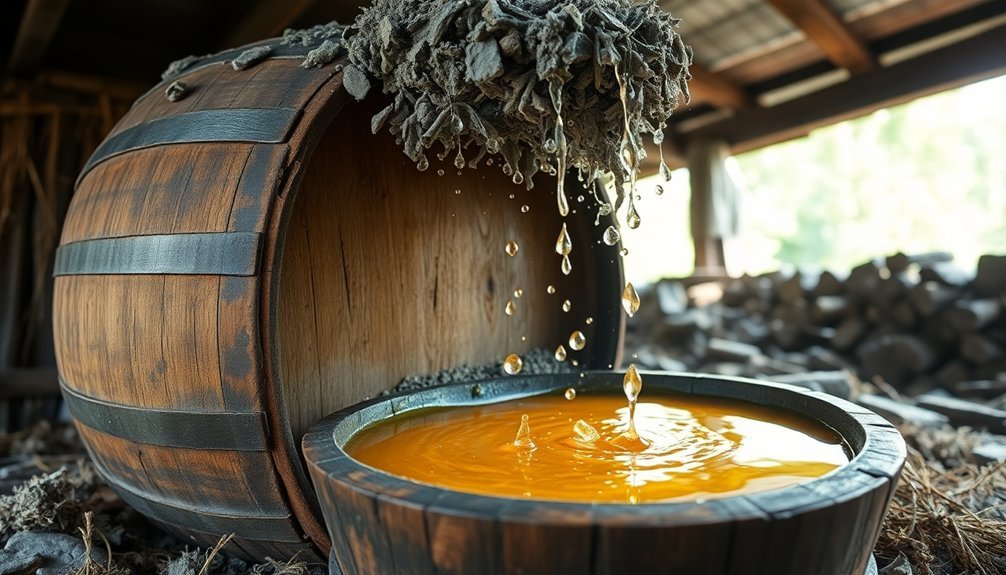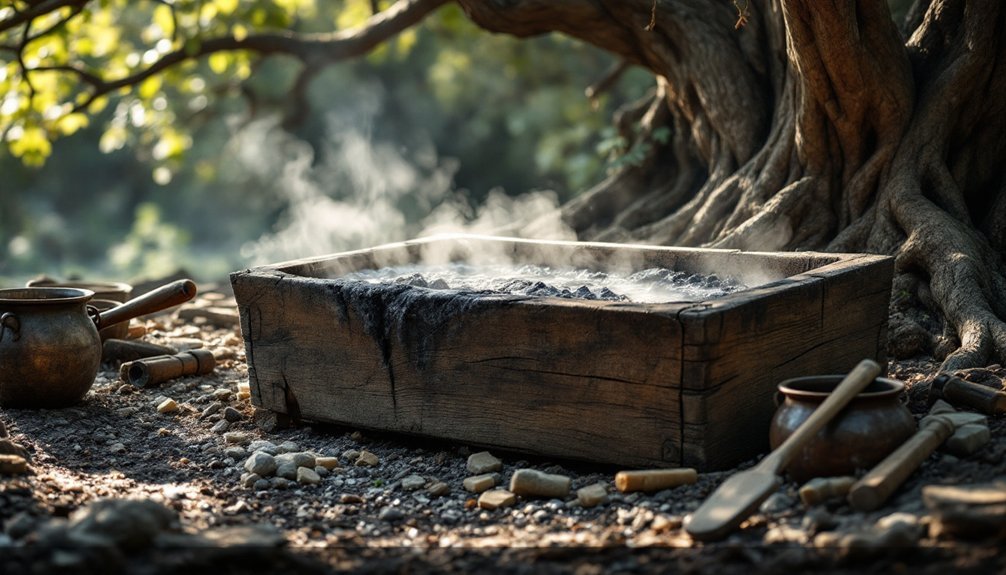Colonial Americans used three primary methods to extract lye from wood ashes. The Barrel Drip Method utilized a bottomless barrel with straw filters where water slowly dripped through ash. The Stone Slab Leaching Technique employed grooved stone slabs to collect the potassium-rich solution. The Ash Hopper System featured a wooden V-shaped structure that allowed continuous lye production. Each method required testing the solution's strength by floating an egg or potato. These traditional techniques reveal our ancestors' remarkable self-sufficiency.
The Barrel Drip Method: Creating Potash Lye From Wood Ashes

Three main components formed the foundation of the barrel drip method: wood ashes, water, and patience.
You'd begin by setting up a bottomless barrel, laying down straw and small sticks at the bottom to prevent ash contamination. This critical filter guaranteed your lye solution remained pure.
Next, you'd fill the barrel with hardwood ashes, then slowly pour water over them. As water percolated through the ashes, it extracted potash, creating lye. The solution would flow through a groove around a stone slab and collect in a clay vessel below. This method was essential for early American settlers who needed to achieve complete self-sufficiency without relying on imported goods from England.
The liquid gold of lye slowly winds its way through ash layers, drawing out potash before collecting in waiting vessels below.
To test strength, you'd float an egg or potato in the solution. If it wasn't strong enough, you could boil it down or pass it through fresh ashes.
Many colonists preferred ash hoppers for continuous production.
The Stone Slab Leaching Technique: Extracting Lye For Household Use
While the barrel drip method gained popularity among most early settlers, another ingenious technique took hold in some regions—the stone slab leaching technique. This method utilized hard rocks like granite or gneiss carved with specialized grooves for collecting and directing lye.
You'd begin by placing the grooved stone slab beneath a leaching container, supported by rocks for elevation. After filling the container with hardwood ashes (preferably oak or hickory) and adding a straw filter layer, you'd pour rainwater through the setup.
As water percolated through the ashes, potassium hydroxide would collect in the circular groove before flowing down the spout into your collection vessel. The process requires proper safety precautions when handling the resulting lye solution to prevent burns or injuries.
To test your lye's concentration, you'd try floating an egg in the solution—a traditional method that guaranteed proper strength for soap-making.
The Ash Hopper System: Sustainable Lye Production For Colonial Homesteads

Colonial homesteads relied heavily on the ash hopper system, perhaps the most sustainable and efficient method of lye production available to early American settlers.
You'd typically find these structures in small sheds, protecting valuable ashes from accidental leaching by rain.
The design was ingeniously simple: an upside-down wooden pyramid or modified barrel with drainage holes at the bottom. Inside, a layer of straw and small stones created a natural filtration system.
You'd slowly pour water over hardwood ashes, allowing it to percolate through and collect as potash-rich lye in a vessel below. The strength of the lye solution could be increased by multiple runs through fresh ashes.
This system enabled continuous production—simply add more ashes and water daily.
While requiring caution due to lye's caustic nature, the hopper provided essential material for soap, laundry, and food preparation.
Frequently Asked Questions
How Dangerous Was Lye-Making to Colonial Children?
You'd have faced significant dangers from lye-making as a colonial child. You're at risk for chemical burns, eye injuries, and accidental ingestion while helping with family soap production tasks.
Could Colonial Soap Be Scented With Herbs or Flowers?
You could scent colonial soap with herbs and flowers. When available, lavender, chamomile, or rose petals might be infused into oils or added directly, though this was likely more common in wealthy households.
How Did Soap Quality Vary Between Seasons?
Your soap's quality varied seasonally due to changing fat availability, ash composition, and temperature conditions. You'd get better results in fall after animal butchering, when high-quality fats were abundant for soap making.
Did Native Americans Teach Colonists Lye-Making Techniques?
No, there's no documented evidence that Native Americans taught colonists lye-making techniques. You'll find that colonists likely brought these practices from Europe, though general knowledge sharing between cultures may have occurred.
How Long Could Colonial-Made Lye Be Stored?
You could store colonial-made lye for several months to a year if you kept it in airtight, wooden containers away from moisture, heat, and sunlight. Proper storage was essential for maintaining its potency.
In Summary
By learning these three colonial lye-making methods, you've glimpsed an essential frontier skill. Whether you're using the barrel drip method, stone slab leaching, or the ash hopper system, you're connecting with practical wisdom that sustained generations of homesteaders. Today, these techniques aren't just historical curiosities—they're valuable skills for those interested in traditional crafts, self-sufficiency, and sustainable living practices.





Leave a Reply